Blue Jay Exterior Renovations was recently selected to complete a siding replacement project in Edmonton, even though our initial quotes for the project came in 24% and 41% higher than estimates from the other contractor. Does this mean that our customer made a poor financial decision? Definitely not, and this article explains why.
If you’ve ever received multiple bids for a home improvement project, you might already know that not all contractor quotes are created equal. A contractor comes to your home, asks you a few questions (maybe), shows you a sample product or two, takes some measurements, and then emails you a quote that’s light on details. That’s exactly what happened in this case.
Here are the bids submitted by our competitor for the project:
James Hardie Siding Estimate
Vinyl Siding Estimate
At first glance, this seems like a good, professional quote: it’s easy to read, there are no typos, and the layout is nice-looking. But when you dig a little bit deeper, there are several major problems:
this is an estimate, not a quote
Since this contractor has only submitted an estimate, their prices are not set in stone. If you sign a contract with a company that has only provided you with an estimate, you might be on the hook for cost overruns that you weren’t anticipating. If a contractor presents you with an accurate quote, overruns are much less likely. It’s a seemingly small difference in wording, but it matters a great deal when you’re adding up the final bill.
2. The scope of work is too vague
35 words. This estimate describes two separate siding replacement projects in just 35 COMBINED words. There is absolutely no way that a $25,000 James Hardie siding project can be summed up in 16 words. This leaves a ton of room for miscommunication, as the customer will never really know what is included and what is not for the project.
Here are just a few of the questions that a customer should have after reading these “descriptions”:
Is haul-away of the old siding included in this price? If so, will it be disposed of legally?
It says “Includes trim at doors/windows.” What kind of trim? How will it be installed?
It says “standard colour vinyl siding.” Which manufacturer’s line of products are you using? What’s the thickness of the siding?
What about all the accessories on the exterior? Will lights be remounted? If so, what will they mount to? Will any vents be changed?
3. The warranty isn’t as great as it sounds
The estimate promises a “limited Lifetime Warranty on workmanship for residential single-family customers.” Sounds great, right? It would be, except for two little words:
Limited: A limited warranty means that there are specific exclusions and limitations to the warranty. This is extremely common, and just about every warranty is limited in some way or another. The important thing here is to request a copy of the company’s written warranty so you can review it for yourself.
Workmanship: Workmanship or Installation warranties are very common for roofing and siding contractors in Edmonton. A workmanship warranty states that the contractor is on the hook for the quality of the installation, and the manufacturer of your material is on the hook for the quality of the materials used. In theory, this makes sense. In practice, it makes sense for everyone except the customer.
When a customer wants to submit a warranty claim for their siding project, in most cases the contractor with the “workmanship warranty” will blame faulty materials. Next, the contractor will encourage the customer to file a claim with the manufacturer. What happens to most manufacturer’s warranty claims? They are usually denied due to improper installation.
These disputes happen all the time, and unsuspecting homeowners are the ones who end up stuck in the middle of a never ending run-around.
4. The “low-ball” bid
For this one, we’ll just look at the vinyl siding section of the estimate. When we met with the homeowners, they told us how much they liked the dark siding colours that were available. That’s why our quote included upgrades for dark siding and black accessories throughout.
The other contractor’s vinyl siding estimate uses “standard colours” only. Since standard colours are quite a bit less expensive than the dark colour lines, this makes the project look artificially cheaper than it will be in reality.
There is a common sales trick in home improvement where the company intentionally underbids the project, knowing that many customers will jump at the chance to get what looks like a great deal. Then once their foot is in the door, the contractor pumps the price up by adding back in all the options and upgrades that the customer requested in the first place.
Now, we don’t know if this contractor was trying to low-ball the bid on purpose, or if they simply made a mistake; but either way the customer has an estimate that doesn’t reflect the project they requested.
5. What are the payment terms?
This company’s estimate does a good job of telling the customer how they can make payments, but it doesn’t describe when payments must be made, or how much those payments will be.
Is a deposit due when the contract is signed? Is there a deficiency hold back, and if so, how much is it? Are there defined payment points in the process, or does the contractor just ask me for more money whenever he happens to run out?
Knowing the terms and conditions of the sale is an essential part of evaluating a contractor’s bid for the job.
6. There’s one massive red flag
“Re-use house wrap, repair/tape up as needed.”
Umm, excuse me?
There’s really no way to explain this line item, except to say that the contractor is cutting a corner to try to win the job, and it’s a disgrace. A siding contractor focused on quality would never re-use old tar paper or Tyvek when installing new siding.
Think of it this way: to apply house wrap to the wall, it’s industry standard to use a hammer-tacker to staple it up. On average, you’ll see 8 to 12 staples for every 10 square feet of house wrap. Then, your siding gets installed, which will add about 2,000 to 3,000 more nail holes for the average house.
A gallery of uncovered tar paper
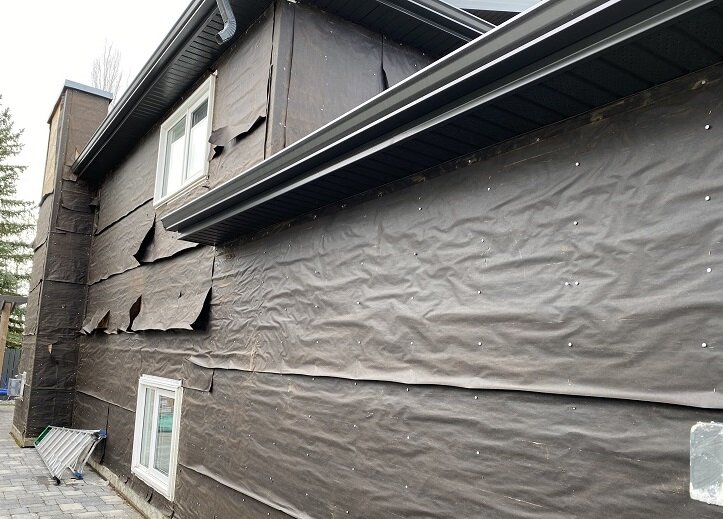
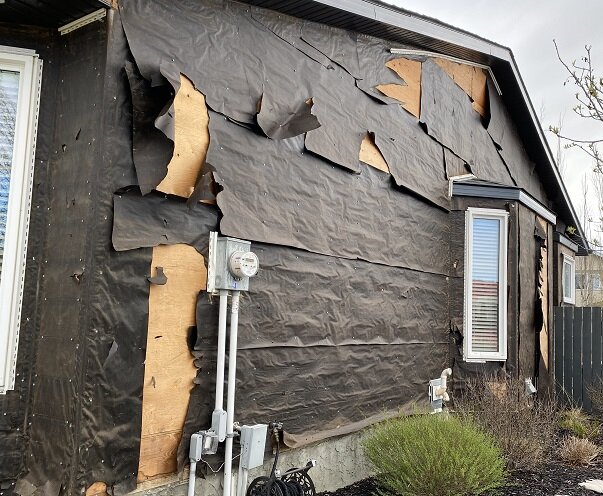
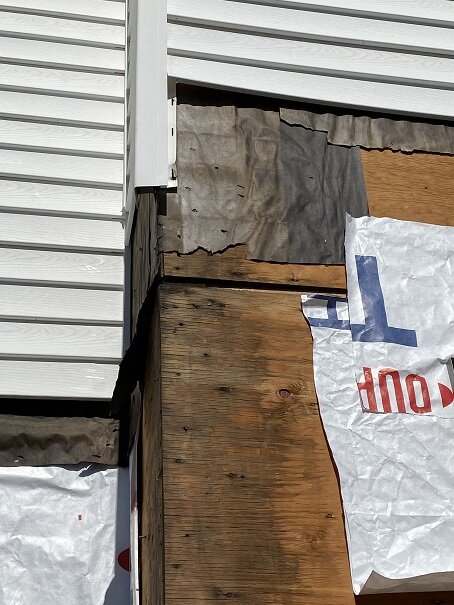
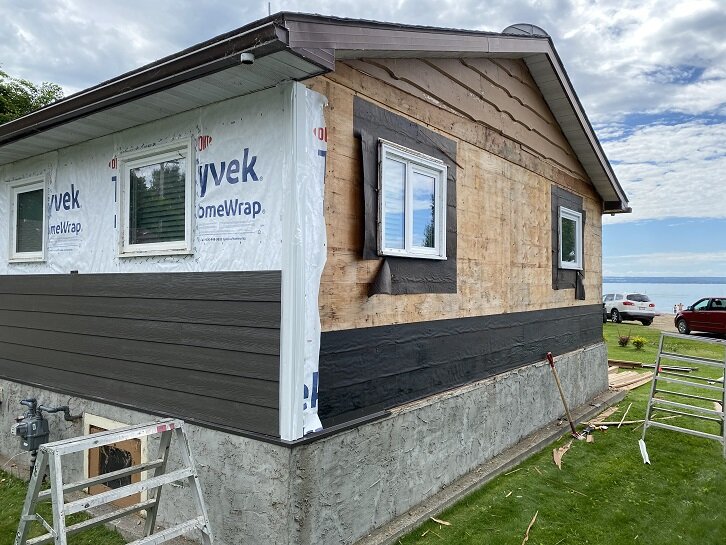
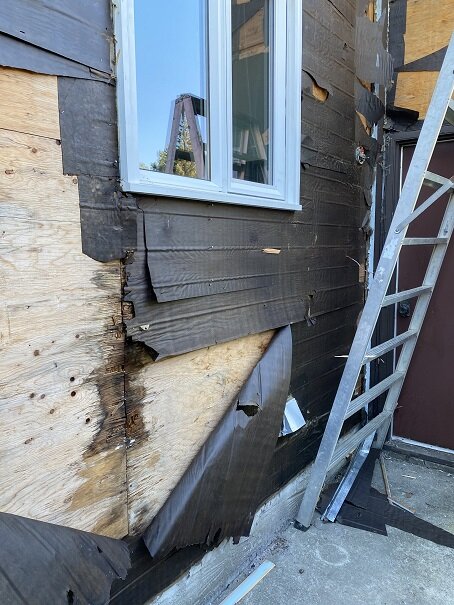
Now, imagine ripping off the old siding, “patching up” the old house wrap, and punching ANOTHER 3,000 holes into it with new siding? And by the way, standard tuck tape doesn’t stick to tar paper. So, unless the contractor is planning to patch every hole with $40/roll peel & stick tape (spoiler alert: they aren’t) even the repairs don’t make any sense.
7. This contractor might actually be breaking the law
Contractors in Alberta must follow the rules in the Consumer Protection Act. If a contractor meets a customer in any location other than their office or storefront, and takes any payment at all before the work is 100% complete, the contractor must be licensed as a prepaid contractor with the Government of Alberta.
The contractor that submitted this estimate is not properly licensed. In fact, the vast majority of siding contractors in Edmonton are not licensed as prepaid contractors.


